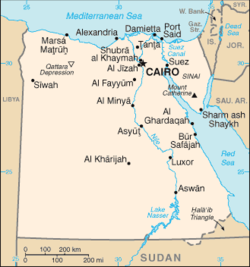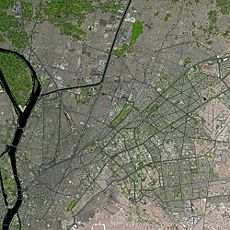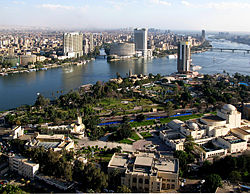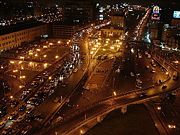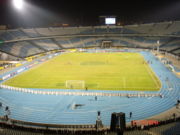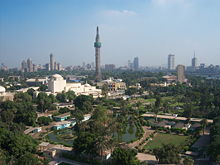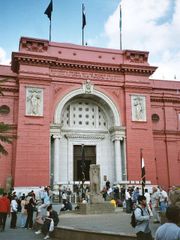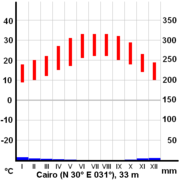Cairo
2008/9 Schools Wikipedia Selection. Related subjects: Africa; Cities; Geography of the Middle East
| Cairo القـــاهــرة |
|||
 The City that never sleeps |
|||
|
|||
| Egypt: Site of Cairo (top centre) | |||
| Coordinates: | |||
|---|---|---|---|
| Government | |||
| - Governor | Dr. Abdul Azim Wazir | ||
| Area | |||
| - City | 214 km² (82.6 sq mi) | ||
| - Metro | 5,360 km² (2,069.5 sq mi) | ||
| Population (2006) | |||
| - City | 7,734,334 | ||
| - Density | 35,047/km² (90,771.3/sq mi) | ||
| - Metro | 17,856,000 | ||
| Time zone | EET ( UTC+2) | ||
| - Summer ( DST) | EEST ( UTC+3) | ||
| Website: www.cairo.gov.eg | |||
Cairo ( Arabic: القاهرة transliteration: Al-Qāhirah), which means "The Vanquisher" or "The Triumphant", is the capital city of Egypt. It is the largest city in Egypt and Africa's most populous city. While Al-Qahirah is the official name of the city, in Egyptian Arabic it commonly shares the dialect's name for the country, transliteration: Masr. Inhabitants of Cairo are called Masraweya rather than Masri within Egypt.
Cairo was founded by the Fatimid caliphs as a royal enclosure, and replaced Fustat as the seat of the government. It later came under the Mamluks, ruled by the Ottomans 1517 to 1798, briefly occupied by Napoleon. Muhammad Ali of Egypt made Cairo the capital of his independent empire from 1805 to 1882, after which the British took control of it until Egypt attained independence in 1952.
Cairo has a population of about 7.7 million people, while its metropolitan area has a population of about 17.285 million people. Cairo is the sixteenth most populous metropolitan area in the world. It is also the most populous metropolitan area in Africa.
Today, Greater Cairo encompasses various historic towns and modern districts into one of the most populous cities in the world. A journey through Cairo is a virtual time travel: from the Pyramids, Saladin's Citadel, the Virgin Mary's Tree, the Sphinx, and Heliopolis, to Al-Azhar, the Mosque of Amr ibn al-A'as, Saqqara, the Hanging Church, and the Cairo Tower. It is the Capital of Egypt, and indeed its history is intertwined with that of the country. Today, Cairo's official name is Al-Qahira (Cairo), although the name informally used by most Egyptians is "Masr" ( Egyptian Arabic name for Egypt), from the original name of Egypt's first Arab capital Fustat, Misr al-Fustat, "City of the Tents."
Etymology
The name Al-Qahirah has been said to mean "the Subduer", and it's often translated as "the Victorious". In German, the victor is called the sieger, which is relate to the English word siege, which means "throne", "seat", and also "to besiege", "assail", or "beset".
The origin of Al-Qahirah is said to come from the appearance of the planet Mars during the foundation of the City of Cairo. The planet Mars, which in Greek was called Aries, was associated with ruin or destruction and was called Al Najm Al Qahir in Arabic. Al Najm Al Qahir is transliterated as "the destroyer star [planet]". The legacy of the name evolved into “Qahirat Al Adaa” meaning “subduer of the enemies”. This title was given to the city as many armies were destroyed in attempts to invade Cairo or defeated elsewhere by troops sent from the settlement. The Arabic word "qa'id" means commander of the castle or fortress. "Alqaida" means base or camp. The root of these words is seen in the Romanized Arabic word "qa'ad", which means to live, dwell, or sit, which in Swahili is "kaa". The prefix of Qahirah is related to the English words chair [throne] and couch. "Qa" corresponds to the Latin word "cola" meaning seat [tail] and cultivated land. "Colline" means a hill. The prefix of Cairo may also mean the landing or the quay, the small hill by the river, that serves as a wharf. Arabic "kharab" is transliterate as the "settlement ruins". From "kharab" come the English words harbinger and harbour. In Swahili, "harabu" means to ruin or destroy, and the Persian word "karo" means army or the camp of an army. Cairo then means the "camp wars", the "colony harries", which comes from Mars, or Aries--the Camp of the God of War, the Camp of the Harrier. German "heer" means army.
History
The city was founded in 969 AD as the royal enclosure for the Fatimid caliphs, while the actual economic and administrative capital was in nearby Fustat. After Fustat was destroyed in 1168/1169 to prevent its capture by the Crusaders, the administrative capital of Egypt moved to Cairo, where it has remained ever since. It took four years for the General Jawhar Al Sikilli (the Sicilian) to build Cairo and for the Fatimid Calif Al Muizz to leave his old Mahdia in Tunisia and settle in the new Capital of Fatimids in Egypt.
After Memphis, Heliopolis, Giza and the Byzantine fortress of Babylon-in-Egypt, Fustat was itself a new city built as a military garrison for Arab troops and was the closest central location to Arabia that was accessible to the Nile. Fustat became a regional centre of Islam during the Umayyad period and was where the Umayyad ruler, Marwan II, made his last stand against the Abbasids. Later, during the Fatimid era, Al-Qahira (Cairo) was officially founded in 969 as an imperial capital just to the north of Fustat. Over the centuries, Cairo grew to absorb other local cities such as Fustat, but the year 969 is considered the "founding year" of the modern city.
In 1250, the slave soldiers or Mamluks seized Egypt and ruled from their capital at Cairo until 1517, when they were defeated by the Ottomans. Napoleon's French army briefly occupied Egypt from 1798 to 1801, after which an Ottoman officer named Muhammad Ali made Cairo the capital of an independent empire that lasted from 1805 to 1882. The city then came under British control until Egypt attained independence in 1922.
Geography
Cairo is located on the banks and islands of the Nile River in the north of Egypt, immediately south of the point where the river leaves its desert-bound valley and breaks into two branches into the low-lying Nile Delta region.
The oldest part of the city is east of the river. There, the city gradually spreads west, engulfing the agricultural lands next to the Nile. These western areas, built on the model of Paris by Ismail the Magnificent in the mid-19th century, are marked by wide boulevards, public gardens, and open spaces. The older eastern section of the city is very different: having grown up haphazardly over the centuries it is filled with small lanes and crowded tenements. While western Cairo is dominated by the government buildings and modern architecture, the eastern half is filled with hundreds of ancient mosques that act as landmarks.
Extensive water systems have also allowed the city to expand east into the desert. Bridges link the Nile islands of Gezira and Roda, where many government buildings are located and government officials live. Bridges also cross the Nile attaching the city to the suburbs of Giza and Imbabah (part of the Cairo conurbation).
West of Giza, in the desert, is part of the ancient necropolis of Memphis on the Giza plateau, with its three large pyramids, including the Great Pyramid of Giza. Approximately 11 miles (18 km) to the south of modern Cairo is the site of the ancient Egyptian city of Memphis and adjoining necropolis of Saqqara. These cities were Cairo's ancient predecessors, when Cairo was still in this approximate geographical location.
In Cairo, and along the Nile River Valley, the climate is hot desert (BWh) according to the Köppen climate classification system, but often with high humidity due to the river valley's latent effects. Wind storms can be frequent, bringing Saharan dust into the city, during the months of March and April. High temperatures in winter range from the 15°C to the low 20s, while nighttime lows drop to below 10°C, often to 5°C. In Summer, the highs often surpass 40°C, and lows drop to about 20°C. Rainfall is sparse, but sudden showers do cause flooding.
| Weather averages for Cairo | |||||||||||||
|---|---|---|---|---|---|---|---|---|---|---|---|---|---|
| Month | Jan | Feb | Mar | Apr | May | Jun | Jul | Aug | Sep | Oct | Nov | Dec | Year |
| Average high °C (°F) | 18 (64) | 21 (70) | 24 (75) | 28 (82) | 33 (91) | 35 (95) | 36 (97) | 35 (95) | 32 (90) | 30 (86) | 26 (79) | 20 (68) | 28 (82) |
| Average low °C (°F) | 8 (46) | 9 (48) | 11 (52) | 14 (57) | 17 (63) | 20 (68) | 21 (70) | 22 (72) | 20 (68) | 18 (64) | 14 (57) | 10 (50) | 15 (59) |
| Precipitation mm (inches) | 0 (0) | 0 (0) | 0 (0) | 0 (0) | 0 (0) | 0 (0) | 0 (0) | 0 (0) | 0 (0) | 0 (0) | 0 (0) | 0 (0) | 20 (0.8) |
| Source: Weatherbase 2008-04-14 | |||||||||||||
Infrastructure
Health
Cairo, as well as neighbouring Giza, has been established as Egypt's main centre for medical treatment, and despite some exceptions, has the most advanced level of medical care in the country. Cairo's hospitals include As-Salam International Hospital- Corniche El Nile; Maadi (Egypt's largest private hospital with 350 beds), Ain Shams University Hospital, Dar El Fouad Hospital, as well as Qasr El Ainy General Hospital.
Education
Cairo has long been the hub of education and educational services not only for Egypt but also for the whole Arab world. Today, Cairo is the centre for many government offices governing the Egyptian educational system, has the largest number of educational schools, and higher learning institutes among other cities and governorates of Egypt.
Some of the International Schools found in Cairo include:
- El Alsson School (EA)
- El-Salam College English School
- Deutsche Evangelische Oberschule (DEO Cairo)
- Deutsche Schule der Borromäerinnen (DSB Cairo)
- American International School (AIS Cairo)
- British International School in Cairo (BISC)
- International School of Choueifat
- Collège de La Salle - Freres - Daher (DLS)
- Collège de la Sainte Famille (CSF)
- New Cairo British International School (NCBIS)
- Rajac Language and American Schools (RLS)
- Cairo American College (CAC)
- British Book Centre International School (BBC)
- Modern English School (MES)
Universities in Cairo:
- Al-Azhar University in Cairo
- Ain Shams University
- The American University in Cairo ( AUC)
- The Russian University in Cairo
- Arab Academy for Science & Technology and Maritime Transport
- Al Azhar University - One of the oldest universities in use today
- British University in Egypt (BUE)
- Canadian International College (CIC)
- Cairo University
- German University in Cairo (GUC)
- Helwan University
- Misr International University (MIU)
- Misr University for Science and Technology (MUST)
- Nile University
- Sekem University
- Modern Sciences and Arts University (MSA)
- Modern Academy In Maadi (MAM)
Transport
Transportation in Cairo comprises an extensive road network, rail system, subway system and maritime services. Cairo is the centre of almost the entire Egyptian transportation network.
The subway system, called 'The Metro' locally, is a fast and efficient way of getting around Cairo. It can get very crowded during rush hour. Two train cars (the fourth and fifth ones) are reserved for women only.
An extensive road network connects Cairo with other Egyptian cities and villages. There is a new Ring Road that surrounds the outskirts of the city, with exits that reach to almost every Cairo district. There are flyovers, and bridges such as the Sixth of October bridge that allows straight, fast and efficient means of transportation from one side of the city to the other.
Cairo traffic is known to be overwhelming and overcrowded. Traffic moves at a relatively fluid pace. Drivers tend to be aggressive, but are more courteous at intersections, taking turns going, with police aiding in traffic control of some congested areas.
- Cairo International Airport
- Ramses Railway Station
- Ahmed Helmy Bus Stop
- Abbood Bus Stop
- Cairo Metro
- Cairo Tram
- Cairo Transportation Authority CTA
- Cairo Taxi
- Cairo Yellow Cab
- Cairo Nile Ferry
Sports
Football is the most popular sport in Egypt, and Cairo has a number of sporting teams that compete in national and regional leagues. The best known teams are Al Zamalek and Al Ahly, whose annual football tournament is perhaps the most watched sports event in Egypt as well as the African and Arabian World. Both teams are known as the "rivals" of Egyptian football, and are the first and the second champions in the African continent and the Arab World. Both teams play their home games at Cairo International Stadium or Naser Stadium , which is Cairo's, Egypt's, Africa's and Middle East's largest stadium and one of the largest in the world.
The Cairo International Stadium was built in 1960 and its multi-purpose sports complex that houses the main football stadium, an indoor stadium, several satellite fields that held several regional, continental and global games, including the African Games, U17 Football World Championship and was one of the stadiums scheduled that hosted the 2006 African Nations Cup which was played on January, 2006, which Egypt won its title for the record number of five times in African Continental Competition's history.
Cairo failed at the applicant stage when bidding for the 2008 Summer Olympic Games, which will be hosted in Beijing China. However, Cairo will host the Pan-Arab Games this year and next year.
There are several other sports teams in the city that participate in several sports including el Gezira Sporting Club, el Shams Club, el Seid Club, Heliopolis Club and several smaller clubs, but the biggest clubs in Egypt (not in area but in sports) are Al Zamalek & Al Ahly. They have the two biggest football teams in Egypt.
Most of the sports federations of the country are also located in the city suburbs, including the Egyptian Football Association. The headquarters of the Confederation of African Football (CAF) was previously located in Cairo, before relocating to its new headquarters in 6 October City, a small city away from Cairo's crowded districts.
Culture
Over the ages, and as far back as seven thousand years, Egypt stood as the land where civilizations have always met. The Pharaohs together with the Greeks and the Romans have left their imprints here. Muslims from the Arab Peninsula, led by Amr ibn al-A'as, introduced Islam into Egypt. Khedive Mohammad Ali, with his Albanian family roots, put Egypt on the road to modernity. If anything, the cultural mix in this country is natural, given its heritage. Egypt can be likened to an open museum with monuments of the different historical periods on display everywhere.
Cairo Opera House
President Mubarak inaugurated the new Cairo Opera House of the Egyptian National Cultural Centre on October 10, 1988, seventeen years after the Royal Opera House had been destroyed by fire. The National Cultural Centre was built with the help of JICA, the Japan International Co-operation Agency and stands as a prominent feature for the Japanese-Egyptian co-operation and the deep-rooted friendship between these two nations.
Thus, the joint efforts of Japanese and Egyptians has given rise to a unique landmark which celebrates the rich and diverse cultural life not only of Egypt but of neighboring nations in Africa and the Middle East as well.
Egypt is proud to be the only state in the region which built two opera houses within a bit more than a century.
Khedivial Opera House
The Khedivial Opera House or Royal Opera House was the original opera house in Cairo, Egypt. It was dedicated on November 1, 1869 and burned down on October 28, 1971. After the original opera house was destroyed, Cairo was without an opera house for nearly two decades until the opening of the new Cairo Opera House in 1988.
Cairo International Film Festival
Egypt's love of the arts in general can be traced back to the rich heritage bequeathed by the Pharaohs. In modern times, Egypt has enjoyed a strong cinematic tradition since the art of filmmaking was first developed, early in the 20th century. A natural progression from the active theatre scene of the time, cinema rapidly evolved into a vast motion picture industry. This together with the much older music tradition, raised Egypt to become the cultural capital of the Arab world.
For more than 500 years of recorded history, Egypt has fascinated the West and inspired its creative talents from play writer William Shakespeare, poet and dramatist John Dryden, and novelist and poet Lawrence Durrell to film producer Cecil B. de Mille. Since the silent movies Hollywood has been capitalising on the box-office returns that come from combining Egyptian stories with visual effects.
Egypt has also been a fount of Arabic literature, producing some of the 20th century's greatest Arab writers such as Taha Hussein and Tawfiq al-Hakim to Nobel Laureate, novelist Naguib Mahfouz. Each of them has written for the cinema.
With these credentials, it was clear that Cairo should aim to hold an international film festival. This dream came true on Monday August 16, 1976, when the first Cairo International Film Festival was launched by the Egyptian Association of Film Writers and Critics, headed by Kamal El-Mallakh. The Association ran the festival for seven years until 1983.
This achievement lead to the President of the Festival again contacting the FIAPF with the request that a competition should be included at the 1991 Festival. The request was granted.
In 1998, the Festival took place under the presidency of one of Egypt's leading actors, Hussein Fahmy, who was appointed by the Minister of Culture, Farouk Hosni, after the death of Saad El-Din Wahba.
Four years later, the journalist and writer Cherif El-Shoubashy became president.
For 29 years, the home of the Pyramids and Nile has hosted international superstars like Nicolas Cage , John Malkovich, Morgan Freeman, Bud Spencer, Gina Lollobrigida, Ornella Mutti, Sophia Loren, Claudia Cardinale, Victoria Abril, Elizabeth Taylor, Shashi Kapoor, Alain Delon, Greta Scacchi, Catherine Deneuve, Peter O'toole, Christopher Lee, Irene Pappas, Marcello Mastroianni and Omar Sharif, as well as great directors like Robert Wise, Elia Kazan, Vanessa Redgrave, Oliver Stone, Roland Joffe, Carlos Saura, Ismail Merchant and Michel Angelo Antonioni, in an annual celebration and examination of the state of cinema in the world today.
Cairo Geniza
The Cairo Geniza is an accumulation of almost 200,000 Jewish manuscripts that were found in the genizah of the Ben Ezra synagogue (built 882) of Fostat, Egypt (now Old Cairo), the Basatin cemetery east of Old Cairo, and a number of old documents that were bought in Cairo in the later 19th century. These documents were written from about 870 to as late as 1880 AD and have now been archived in various American and European libraries. The Taylor-Schechter collection in the University of Cambridge runs to 140,000 manuscripts; there are a further 40,000 manuscripts at the Jewish Theological Seminary of America.
The Wagh El-Birket
The Wagh El-Birket ("The Berka") was, into the first half of the 20th century, the entertainment district (or red-light district) of Cairo, Egypt. It features prominently in several novels by Naguib Mahfouz, particularly his Cairo Trilogy. It is a little north of Azbakeya.
Later, during the Second World War, the British military set up brothels run by the Royal Army Medical Corps.
Al-Azhar Park
Inaugurated in May 2005, Al-Azhar Park is located adjacent to Cairo's Darb al-Ahmar district. The Park was created by the Historic Cities Support Programme (HCSP) of the Aga Khan Trust for Culture (AKTC), an entity of the Aga Khan Development Network, and was a gift to Cairo from His Highness the Aga Khan. It is interesting to note that the city of Cairo was founded in the year 969 by the Fatimid Imam-Caliphs who were ancestors of the Aga Khan.
During the development of the park, a part of the 12th century Ayyubid wall was discovered and subsequently restored. The wall had originally been built by Salah al-Din al-Ayubbi as a defense against the crusaders. The discovery prompted additional research into the nearby historic neighbourhood of Darb al-Ahmar, and eventually led to a major project encompassing the restoration of several mosques, palaces and historic houses. The HCSP also established social and economic programs to provide a wide range of assistance for local residents.
Economy
Cairo is also in every respect the centre of Egypt, as it has been almost since its founding in 969 AD. 20% of all Egyptians live there. The majority of the nation's commerce is generated there, or passes through the city. The great majority of publishing houses and media outlets and nearly all film studios are there, as are half of the nation's hospital beds and universities. This has fueled rapid construction in the city—one building in five is less than 15 years old.
This astonishing growth until recently surged well ahead of city services. Homes, roads, electricity, telephone and sewer services were all suddenly in short supply. Analysts trying to grasp the magnitude of the change coined terms like "hyper-urbanization." On the ground planners struggled. Only bits of the Cairo Master Plan of 1970 and the Greater Cairo Master Scheme of 1982 were ever implemented.
Tourism
The Egyptian Museum
The Museum of Egyptian Antiquities, known commonly as the Egyptian Museum, is home to the most extensive collection of ancient Egyptian antiquities in the world. It has 136,000 items on display, with many more hundreds of thousands in its basement storerooms.
Khan El-Khalili
Khan el-Khalili is for many the most entertaining part of Cairo. It is an ancient shopping area, nothing less, but some of the shops have also their own little factories or workshops.
The suq (which is the Arabic name for bazaar, or market) dates back to 1382, when Emir Djaharks el-Khalili built a big caravanserai (or khan) right here. A caravanserai was a sort of hotel for traders, and usually the focal point for economic activity for any surrounding area. This caravanserai is still there, you just ask for the narrow street of Sikka Khan el-Khalili and Badestan.
Old Cairo
The part of Cairo that contains Coptic Cairo and Fostat, which contains the Coptic Museum, Babylon Fortress, Hanging Church, the Greek Church of St. George, many other Coptic churches, the Ben Ezra Synagogue and Amr ibn al-'As Mosque.
Cairo Tower
The Cairo Tower is free-standing concrete TV tower in Cairo. It stands in the Zamalek district on Gezira Island in the River Nile, in the city centre. At 187 metres, it is 43 metres higher than the Great Pyramid of Giza, which stands some 15 km to the southwest.
Pollution
Cairo is a rapidly expanding city, which has led to many environmental problems. The air pollution in Cairo is a matter of serious concern. Greater Cairo's volatile aromatic hydrocarbon levels are higher than many other similar cities. Air quality measurements in Cairo have also been recording dangerous levels of lead, carbon dioxide, sulphur dioxide, and suspended particulate matter concentrations due to decades of unregulated vehicle emissions, urban industrial operations, and chaff and trash burning. There are over 2,000,000 cars on the streets of Cairo, 60% of which are over 10 years old, and therefore lack modern emission cutting features like catalytic converters. Cairo has a very poor dispersion factor because of lack of rain and its layout of tall buildings and narrow streets, which create a bowl effect. A mysterious black cloud (as Egyptians refer to it) appears over Cairo every fall and causes serious respiratory diseases and eyes irritations for the city citizens. Tourists who are not familiar to that high level of pollution must take extra care.
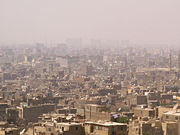
Cairo also has many unregistered lead and copper smelters which heavily pollute the city. The results of this has been a permanent haze over the city with particulate matter in the air reaching over three times normal levels. It is estimated that 10,000 to 25,000 people a year in Cairo die due to air pollution-related diseases. Lead has been shown to cause harm to the central nervous system and neurotoxicity particularly in children. In 1995, the first environmental acts were introduced and the situation has seen some improvement with 36 air monitoring stations and emissions tests on cars. 20,000 buses have also been commissioned to the city to improve congestion levels, which are very high.
The city also suffers from a high level of land pollution. Cairo produces 10,000 tons of rubbish each day, 4,000 tons of which is not collected or managed. This once again is a huge health hazard and the Egyptian Government is looking for ways to combat this. The Cairo Cleaning and Beautification Agency was founded to collect and recycle the rubbish; however, they also work with the Zabbaleen (or Zabaleen ), a community that has been collecting and recycling Cairo's rubbish since the turn of the 20th century and live in an area known locally as Garbage City . Both are working together to pick up as much rubbish as possible within the city limits, though it remains a pressing problem.
The city also suffers from water pollution as the sewer system tends to fail and overflow. On occasion, sewage has escaped onto the streets to create a health hazard. This problem is hoped to be solved by a new sewer system funded by the European Union, which could cope with the demand of the city. The dangerously high levels of mercury in the city's water system has global health officials concerned over related health risks. There is also more concern about environmental issues among Egyptians than beforeThere is now general awareness and some projects are laid down to help make the public aware of the importance of clean environment.
Town twinning (sister cities)
Famous Cairenes
- Abu Sa'id al-Afif - Fifteenth Century Samaritian
- Boutros Boutros-Ghali, former Secretary-General of the United Nations
- Naguib Mahfouz, novelist, Nobel Prize in Literature in 1988.
- Mohamed ElBaradei, Director General of the International Atomic Energy Agency 2005 Nobel Peace Prize laureate
- Dalida Egyptian singer who lived most of her life in France She received 55 golden records and was the first singer to receive a diamond disc .
- Naguib Sawiris, 62nd richest person on earth in a 2007 list of billionaires, reaching US$10.0 billion with his company Orascom Telecom Holding
- Farouk El Baz, a great contributor to NASA
- Sir Magdi Yacoub, leading cardiologist, knight
- Constantin Xenakis (1931) Greek artist
- Voula Zouboulaki (1931) Greek actress
- Raffi Cavoukian, Canadian children's singer, born 1948
- Mohamed Al Fayed, Billionaire owner of Harrods and well known London football team Fulham FC
- Hossam Ghaly, Professional football player with Derby County FC
- Mohamed Shawky, Professional football player with Middlesbrough FC
- Mido, Professional football player with Middlesbrough FC
- Ahmed Zewail- Noble Winner in Chemistry
- Anwar El Sadat- Egyptian President, noble peace prize winner with Israeli Prime Minister
- Omar Sharif- Egyptian Hollywood Actor, Lawrence of Arabia
- Om kalthoum-Diva Singer of the Arab world (also known as 'kawkab al chark' or shrine of the East)

